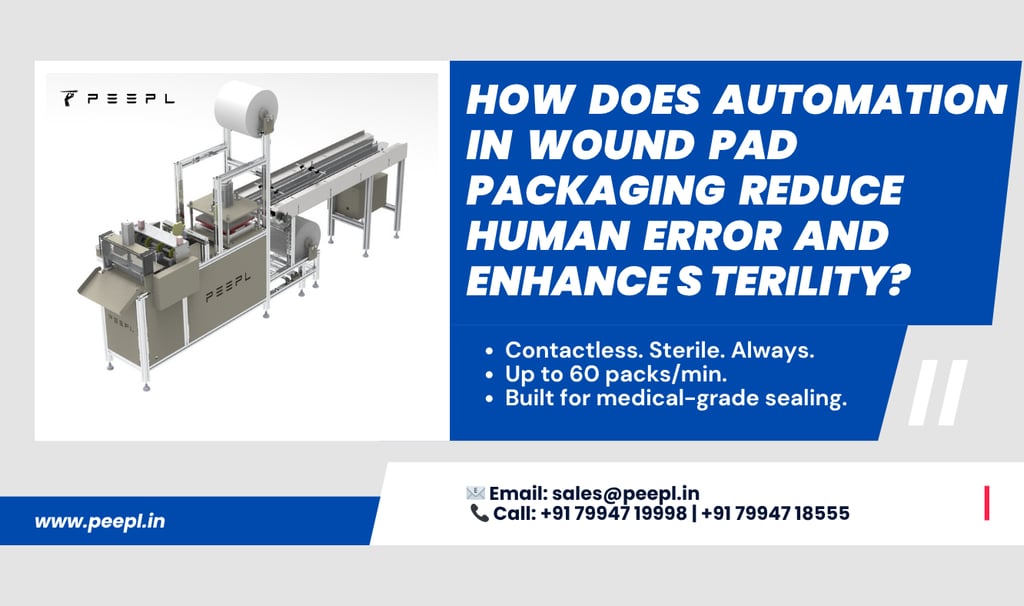How Does Automation in Wound Pad Packaging Reduce Human Error and Enhance Sterility?
7/2/20252 min read


In the medical device industry, packaging isn’t just about protection—it’s about precision and patient safety.
For products like wound pads, consistent and contamination-free packaging is critical. Yet many manufacturers still rely on manual or semi-automated methods, which increase the risk of human error and compromise sterility.
So, how can manufacturers meet the growing demand for clean, compliant, and consistent packaging?
The answer lies in automation—and that’s where PEEPL delivers measurable impact.
The Hidden Costs of Manual Packaging
Manual wound pad packaging methods often result in:
Inconsistent sealing due to operator error
Contamination from repeated human contact
Slower packing speeds and production delays
Inability to meet GMP and ISO sterile packaging standards
Increased product rejection and downtime
In an industry where every sterile seal matters, these inefficiencies aren’t just operational—they're critical liabilities.
The PEEPL Advantage: Introducing the HTS 101
To solve these challenges, PEEPL offers the HTS 101 Outer Pouch Platen Seal Machine, a solution specifically designed for automated, contactless, high-speed wound pad packing.
Product Overview:
Model: HTS 101 – Horizontal Thermo Sealing Machine
Application: Ideal for wound pads, surgical gloves, plasters, sutures, gauze, and diagnostic product packaging
Sealing Method: Platen sealing for firm, uniform, and stable seals before sterilization
Material Compatibility: Works with Paper/Poly, Paper/Paper, Tyvek®, Aluminum foil, and other sealable films
Key Technical Capabilities:
Maximum sealing area: 300 mm x 300 mm
Operating speed: Up to 30 cycles per minute
Output: Up to 60 packs per minute (double lane)
Pouch size compatibility: 170 mm to 285 mm (L) × 140 mm to 160 mm (W)
Eye mark compensation accuracy: ±0.5 mm to ±2.0 mm (depending on material stretchability)
Machine dimensions: 3500 mm (L) × 950 mm (W) × 2100 mm (H)
Paper roll width: 280 mm to 300 mm | Diameter: up to 450 mm | Core: 76 mm
Maximum supported roll weight: 60 kg
Key Features:
Contactless Operation – Minimizes contamination and enhances sterility
Teflon-Coated Dies – Prevents sticking and improves durability
SS-304 Contact Parts – Maintains hygiene and corrosion resistance
Aluminum Body – Lightweight yet robust construction
PLC-Controlled Automation – Delivers precise, reliable, and repeatable sealing
Why PEEPL?
PEEPL is not just a manufacturer—we are India’s trusted partner in medical packaging automation. Our solutions are:
Backed by in-house R&D tailored to healthcare applications
Custom-engineered for each client’s unique packaging needs
Designed for GMP compliance and sterile barrier requirements
Proven in high-demand hospital and export-grade production lines
We work closely with India’s top medical device and disposable manufacturers to help them scale output while maintaining product integrity.
Automation That Protects and Performs
Automated sealing systems like the HTS 101 ensure:
✔️ Uniform sealing without manual variation
✔️ Higher production throughput
✔️ Significantly reduced contamination risks
✔️ Full traceability and process control
✔️ Seamless integration into sterile packaging environments
In today’s post-pandemic world, automation isn’t just about speed—it’s about raising sterility assurance to a whole new level.
Ready to Upgrade Your Wound Pad Packaging?
With the HTS 101, you eliminate guesswork, reduce contamination, and seal with confidence. Let PEEPL Automation help you build a faster, cleaner, and future-ready packaging line.
👉 Learn more at www.peepl.in 📧 Email: sales@peepl.in 📞 Call: +91 79947 19998 | +91 79947 18555
